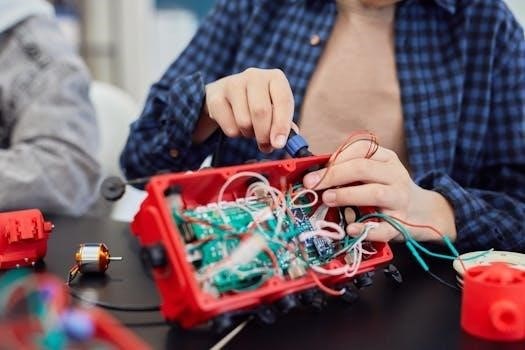
Grokking Machine Learning PDF⁚ A Comprehensive Guide
Embark on a journey to master machine learning with readily available resources. Discover techniques that you can easily understand and apply. This guide will provide valuable insights into the field. Learn with standard Python and readily available tools.
“Grokking Machine Learning” aims to dispel the myth that machine learning is difficult.
The book teaches how to apply ML to projects using standard Python code and high school-level
math. No specialist knowledge is required to tackle the exercises using Python and readily
available machine learning tools.
The book focuses on supervised learning algorithms for classifying and splitting data, methods
for cleaning and simplifying data, machine learning packages and tools, and neural networks and
ensemble methods for complex datasets.
The term “grokking,” or delayed generalization, refers to a transition to generalization that
occurs many training iterations after the interpolation threshold, after many iterations of
seemingly little progress. This is in contrast to the usual process where generalization occurs
slowly and progressively once the interpolation threshold has been reached.
The book provides a comprehensive guide to applying ML to your projects using only standard Python code and high school-level math.
Key Concepts Covered in Grokking Machine Learning
“Grokking Machine Learning” delves into several key concepts vital for understanding and
applying machine learning techniques. The book emphasizes supervised learning algorithms,
which are crucial for tasks like classification and data splitting. These algorithms form the
foundation for many practical machine learning applications.
Furthermore, the book explores methods for cleaning and simplifying data. Data preprocessing
is a critical step in any machine learning project, and this section provides valuable
techniques for ensuring data quality and relevance. The book also covers essential machine
learning packages and tools, enabling readers to leverage existing libraries and frameworks
for efficient development.
In addition to fundamental concepts, “Grokking Machine Learning” introduces neural networks
and ensemble methods for handling complex datasets. These advanced techniques allow readers
to tackle more challenging problems and build sophisticated models. The book aims to provide
a comprehensive overview of these key concepts, empowering readers to apply them effectively
in their own projects.
Supervised Learning Algorithms
“Grokking Machine Learning” dedicates significant attention to supervised learning algorithms,
a cornerstone of many machine-learning applications. These algorithms learn from labeled data,
where the desired output is provided for each input. This enables the model to predict outcomes
for new, unseen data based on the patterns it has learned. The book provides insights into
algorithms for classifying and splitting data, essential techniques for various tasks.
The book covers a range of supervised learning algorithms, including linear regression,
logistic regression, decision trees, and support vector machines. Each algorithm is
explained with clear examples and practical applications, making it easy for readers to
grasp the underlying principles and implement them in their own projects. By understanding
these algorithms, readers can effectively tackle various predictive modeling problems.
Furthermore, “Grokking Machine Learning” emphasizes the importance of evaluating the
performance of supervised learning models. Metrics like accuracy, precision, recall, and
F1-score are discussed to provide a comprehensive understanding of model evaluation. The book
equips readers with the knowledge and skills to choose the most appropriate algorithm for
their specific task and evaluate its performance effectively.
Data Cleaning and Preprocessing Techniques
“Grokking Machine Learning” emphasizes the critical role of data cleaning and preprocessing in
achieving optimal model performance. Real-world datasets are often messy, containing missing
values, inconsistencies, and noise. Addressing these issues is essential to ensure that
machine learning algorithms can learn effectively and produce reliable results. The book
provides methods for simplifying data.
The book covers various data cleaning techniques, including handling missing values through
imputation or removal, dealing with outliers using statistical methods or domain knowledge,
and resolving inconsistencies through data transformation and standardization. These
techniques help to improve the quality and reliability of the data, leading to more accurate
and robust models. The book offers practical examples and code snippets to illustrate how to
implement these techniques using Python and relevant libraries.

Furthermore, “Grokking Machine Learning” explores different data preprocessing techniques,
such as feature scaling, normalization, and encoding categorical variables. These techniques
transform the data into a format that is more suitable for machine learning algorithms,
improving their performance and convergence speed. By mastering these techniques, readers can
effectively prepare their data for machine learning tasks and achieve better results.
Machine Learning Packages and Tools
“Grokking Machine Learning” introduces readers to essential machine learning packages and tools
that streamline the development process. The book emphasizes practical application, guiding
readers on how to effectively leverage these resources to build and deploy machine learning
models.
The book extensively covers Python libraries such as Scikit-learn, a versatile toolkit
providing a wide range of algorithms for classification, regression, clustering, and
dimensionality reduction. Readers will learn how to use Scikit-learn’s intuitive API to
train models, evaluate performance, and fine-tune hyperparameters.
Additionally, the book explores other popular libraries like TensorFlow and Keras, which are
particularly useful for deep learning tasks. Readers will gain hands-on experience with
building neural networks, training them on large datasets, and deploying them for real-world
applications.
Furthermore, “Grokking Machine Learning” introduces tools for data manipulation and
visualization, such as Pandas and Matplotlib. These tools enable readers to efficiently
preprocess data, explore patterns, and communicate insights effectively. By mastering these
packages and tools, readers will be well-equipped to tackle a wide range of machine learning
projects.
Neural Networks and Ensemble Methods
“Grokking Machine Learning” delves into the realms of neural networks and ensemble methods,
two powerful approaches for tackling complex machine learning tasks. Readers will gain a
solid understanding of the underlying principles and practical applications of these
techniques.
The book explores the architecture and training of neural networks, covering topics such as
feedforward networks, backpropagation, and optimization algorithms. Readers will learn how
to build and train neural networks using popular deep learning frameworks like TensorFlow
and Keras. They will also discover techniques for improving network performance, such as
regularization and dropout.
In addition to neural networks, “Grokking Machine Learning” introduces ensemble methods,
which combine multiple individual models to create a more robust and accurate predictor.
The book covers popular ensemble techniques such as bagging, boosting, and random forests.
Readers will learn how to implement these methods using Scikit-learn and how to tune
hyperparameters to achieve optimal performance.
By mastering neural networks and ensemble methods, readers will be equipped to tackle a wide
range of challenging machine learning problems, including image recognition, natural language
processing, and predictive modeling.
Grokking as Delayed Generalization
In machine learning, grokking, or delayed generalization, presents a fascinating phenomenon.
It describes a transition to generalization that occurs significantly later in the training
process. This happens well after the point where the model has seemingly memorized the
training data, known as the interpolation threshold.
Unlike the typical learning process where generalization improves steadily after the
interpolation threshold, grokking involves a prolonged period of minimal progress.
The model appears to be stuck, not improving its performance on unseen data. Then,
suddenly, after many more training iterations, the model “grokks” the underlying patterns
and achieves high accuracy on the validation set.

This delayed generalization defies conventional understanding of how neural networks learn.
It suggests that the model is initially focused on memorizing the training data before
eventually discovering the more generalizable rules. The mechanisms behind grokking are
still being actively researched.
Understanding grokking is crucial for optimizing the training process. It highlights the
importance of monitoring validation performance and continuing training even when progress
seems stagnant. It challenges assumptions about overfitting and encourages exploration of
training techniques.
Applying Machine Learning with High School Math
Many people believe that advanced mathematics is a prerequisite for understanding and
implementing machine learning. However, the core concepts of many machine learning algorithms
can be grasped with a solid foundation in high school math. This realization makes machine
learning more accessible to a wider audience, empowering individuals to explore and apply
these techniques without feeling overwhelmed by complex equations.
Linear algebra, a fundamental branch of mathematics, plays a crucial role in machine learning.
Concepts like vectors, matrices, and matrix operations are essential for representing and
manipulating data. Calculus, particularly derivatives, is used in optimization algorithms like
gradient descent, which are used to train machine learning models. Statistics provides the
tools for data analysis, hypothesis testing, and model evaluation.
By focusing on the intuitive understanding of these mathematical concepts, one can effectively
apply machine learning algorithms. Furthermore, numerous libraries and tools abstract away the
complex mathematical calculations, allowing practitioners to concentrate on problem-solving and
model building. This approach democratizes machine learning, making it possible for individuals
with a high school math background to contribute to this rapidly evolving field.

Preparing for Machine Learning Interviews
Machine Learning (ML) interviews evaluate a candidate’s understanding of machine learning frameworks
like TensorFlow and Scikit-learn, along with core concepts relevant to the company’s specific
field. Expect questions on designing ML systems or pipelines, keeping particular specifications
in mind. A strong grasp of algorithms, data preprocessing, and model evaluation is essential.
Practice coding problems and review fundamental machine learning concepts thoroughly.
Candidates should be prepared to discuss various machine learning algorithms, their underlying
principles, and their strengths and weaknesses. Familiarity with different types of data preprocessing
techniques, such as data cleaning, feature scaling, and dimensionality reduction, is crucial.
Understanding how to evaluate the performance of machine learning models using appropriate metrics
is also vital. Furthermore, experience with building machine learning projects is highly valued.

In addition to technical knowledge, communication skills are also important. Candidates should be
able to articulate their thought processes clearly and concisely, and explain complex concepts in
a simple and understandable manner. Mock interviews and practice sessions can help candidates
improve their communication skills and build confidence. Thorough preparation and a solid understanding
of the fundamentals are key to succeeding in machine learning interviews.
Resources for Further Learning
To deepen your understanding of machine learning beyond “Grokking Machine Learning,” numerous resources
are available. “Pattern Recognition and Machine Learning” by Christopher Bishop offers a comprehensive
theoretical foundation. Explore video lectures from Serrano.Academy for general machine learning
concepts. Andrew Trask’s “Grokking Deep Learning” provides insights into neural networks.
Engage with interactive coding environments to actively apply your knowledge and track your progress.
Consider exploring open-source repositories like the one associated with “Grokking Machine Learning”
on GitHub for practical examples and code implementations. The deeplearning subreddit offers a
community for discussions and knowledge sharing. Look into courses, such as “grokking the machine
learning interview”, that focus on practical skills and interview preparation. Websites like
YouTube offer many videos that cover diverse machine learning topics.
For those interested in the theoretical aspects, research papers on topics like “Omnigrok⁚ Grokking
Beyond Algorithmic Data” and “A Toy Model of Universality⁚ Reverse Engineering How Networks Learn
Group Operations” can provide deeper insights into the inner workings of neural networks. These
resources offer a multifaceted approach to continued learning in the dynamic field of machine
learning.
learning, empowering individuals with a high-school math background to grasp and apply core
concepts. This guide provides a solid foundation in supervised learning algorithms, data
preprocessing techniques, and the utilization of machine learning tools, equipping you with the
knowledge to tackle practical projects. The exploration of neural networks and ensemble methods
further expands your capabilities in handling complex datasets.
Understanding the phenomenon of grokking, or delayed generalization, offers a unique perspective on
how neural networks learn. By supplementing the knowledge gained from “Grokking Machine Learning”
with additional resources, such as textbooks, online courses, and research papers, you can
continue to deepen your understanding and expertise in this ever-evolving field. Preparing for
machine learning interviews becomes less daunting with a solid grasp of fundamental concepts and
practical experience.
Remember that continuous learning and hands-on practice are key to success in machine learning.
Embrace the resources available, engage with the community, and never stop exploring the exciting
possibilities that machine learning offers. With dedication and perseverance, you can unlock the
power of machine learning and apply it to solve real-world problems.